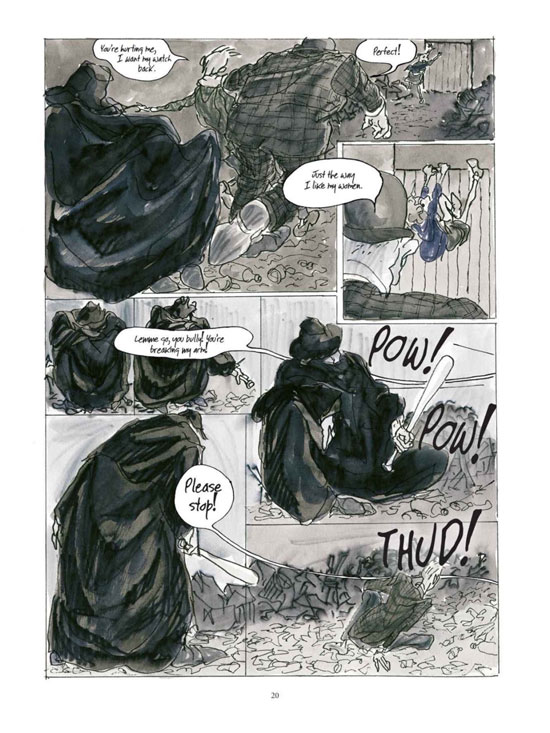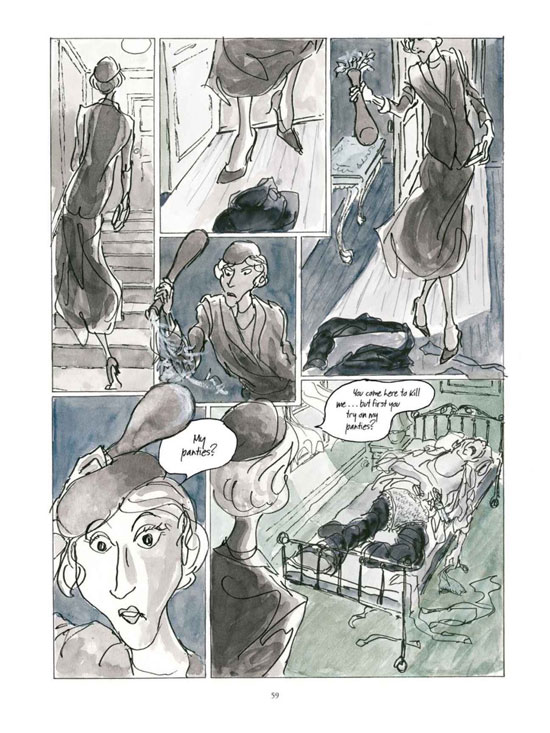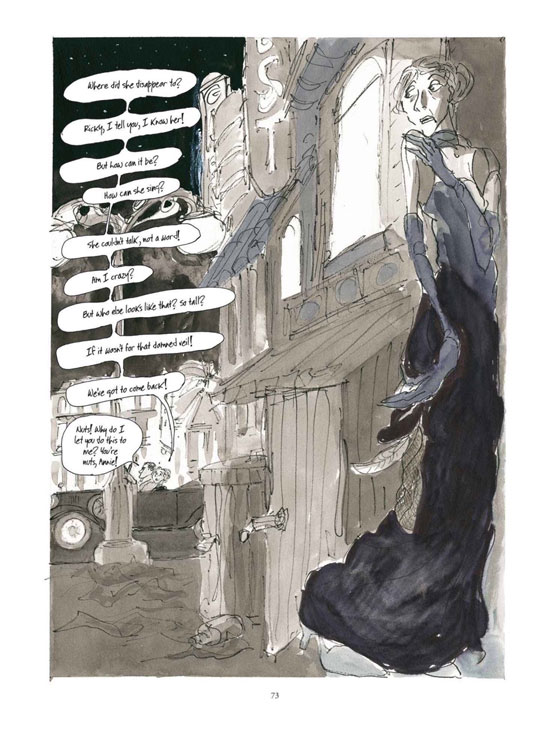Jules Feiffer is an American icon who needs no introduction. His extensive accomplishments over his 86 years have earned him accolades in both film and literature, including an Academy Award in 1961 for the film “Munro” and a Pulitzer in 1986 for editorial cartooning.
Originally from the Bronx, Feiffer has published dozens of books, written plays and screenplays, and has illustrated children's books. His weekly Village Voice cartoon ran for more than 40 years earning him the prestigious George Polk journalism award. He was the first editorial page cartoonist for The New York Times, a position he held for four years.
At the Parrish Art Museum through April 26, Feiffer exhibits the original artwork for his latest work, a film noir graphic novel entitled “Kill My Mother” that is oddly closer to the artist’s earlier work before his name became a household word. This is a good score for the Parish Art Museum and a smart show to arrange as the East End is filled with people who grew up reading Feiffer’s syndicated cartoons and frequently mused on and quoted his wit.
Furthermore the lines between fine art and pop art continue to blur and museum goers nowadays demand more than droll formalism. With this show, the Parish sidles up to any Manhattan museum.
The term graphic novel, a relatively new genre description, has started to come into its own. It is used to distinguish a longer, more sophisticated story line from an ordinary comic book. One recent entry that is considered literature is Art Spiegelman’s “Maus,” an 11-year-long serialized story of the Holocaust, wherein different races were depicted as different types of animals, e.g. Jews as mice, Germans as cats, and Poles (non-Jewish) as pigs.
.

Art Spiegelman's "Maus," 1980-1991.
.
The initial “Maus” reviews came from flummoxed writers, agape that such a horrible subject was rendered in comics, but gradually they warmed up to this startling addition to letters and in 1992 it became the first graphic novel to win the Pulitzer Prize.
Jules Feiffers dark notion of killing one’s mother doesn’t have the storied history of killing one’s father as portrayed in the legend of Oedipus. That tale appears in Homer’s poetry fragments and the Sophocles play “Oedipus the King” and offers a standard interpretation of Shakespeare’s “Hamlet.” Nor did Sigmund Freud recognize a syndrome about killing one’s mother as he did doing in dad with his psychoanalytic invention of the "Oedipus complex.”
There is Stu Silver’s 1987 slapstick comedy “Throw Mama from the Train,” wherein the hapless Billy Crystal and Danny DeVito dream up ridiculous ways to do in DeVito’s mother in exchange for DeVito killing Crystal’s wife. And of course Alfred Hitchcock added a taxidermied mother to his masterpiece “Psycho,” based on serial murderer Edward Theodore Gein’s body snatching and preserving (no actual mother was involved on Gein’s end). For the most part though, Feiffer is not in the mainstream parental murder depiction on this one.
Exactly whose story it is wanders around a bit and is made somewhat more difficult to follow by characters drawn less distinguishable and recognizable over the 162 pages than would be useful to a reader following a convoluted plot.
It’s 1933 and a mother named Elsie goes to work for a hard drinking private eye named Neil Hammond, a friend of her late husband, a Los Angeles policeman. Her latch-key juvenile delinquent daughter Annie takes up shoplifting with boyfriend Artie while continually musing about wacking her mom for vague reasons that only a 15-year-old could invent.
The novel launches itself when Annie and Artie are chased into a blind alley by a store detective where, improbably, a 6-foot, 2-inch blond in a trench coat pummels the store dick, allowing the young miscreants to escape. They adopt her and find a conveniently vacant apartment in their building for her and she thereafter answers casting calls to break into “the movies.”

From "Kill My Mother" by Jules Feiffer (Liveright Publishing Corporation) , 20 x 16 inches.
.
Meanwhile another “blonde dame” shows up at Hammond’s office and offers him a sum of money to locate the tall blonde from the alley. Hammond throws his own fake casting call and reels her in after a few days of interviewing a “parade of big, over-the-hill broads who still think they can be movie stars.” His client returns with a large sum of money and demands that Hammond kill the tall blonde, which he agrees to do.
.

From "Kill My Mother" by Jules Feiffer (Liveright Publishing Corporation) , 20 x 16 inches.
.
Hammond waits in her apartment, gets drunk, and falls asleep in her bed. She returns to find him spread-eagle and wearing her panties over his suit pants. She drags him out of the building into the weeds and shoots him in the head with his own gun.
.

From "Kill My Mother" by Jules Feiffer (Liveright Publishing Corporation) , 20 x 16 inches.
.
Annie and Artie get their own popular radio show and broadcast to the troops over seas, including one infantry company that leaves the radio playing in the woods and then ambushes opposing troops who pause for a listen.
.

From "Kill My Mother" by Jules Feiffer (Liveright Publishing Corporation) , 20 x 16 inches.
.
It seems a bit too much like Raymond Chandler, or at least like Chandler driving a speed boat blind in the fog and landing on an occasional beach and jumping out looking for a plot. Of course Chandler couldn’t draw this well, actually not many can, and it's the brilliantly drawn graphics that carry the book. And Feiffer has long been comfortable with the absurd.
The Parrish show exhibits the original artwork, turning every viewer into a paper sleuth peering closely at the story boards to grasp Feiffer’s uncanny ability to make characters leap off the page into 3D space.
.

From "Kill My Mother" by Jules Feiffer (Liveright Publishing Corporation) , 20 x 16 inches.
.
Work of this caliber could have benefited from a more intimate space, with a lowered ceiling and smaller rooms, perhaps some curved ones; as it is, the exhibition is somewhat like viewing stamps in a coliseum. No installation design is evident, and the artwork doubling as story boards is simply affixed to the pre-existing walls of the spectacular Herzog & de Meuron building.
Not much text is in evidence at the show, apparently that is typed in later by a word processor; this and the extremely convoluted plot make the story almost impossible to follow, but that is not necessary to enjoy this exhibition of Feiffer’s exceptional work.
_________________________
BASIC FACTS: “Jules Feiffer: Kill My Mother” remains on view through April 26, 2015, at the Parish Art Museum, 279 Montauk Highway Water Mill, NY 11976. www.parrishart.org
On Saturday, April 18, at 11 a.m. Jules Feiffer will be at the Parrish for a conversation about “Kill My Mother” and a book signing. The fee is $10, or free for Parrish members, children and students. There is an additional $30 fee for book pre-orders; includes museum admission.
_________________________
Copyright 2015 Hamptons Art Hub LLC. All rights reserved.
